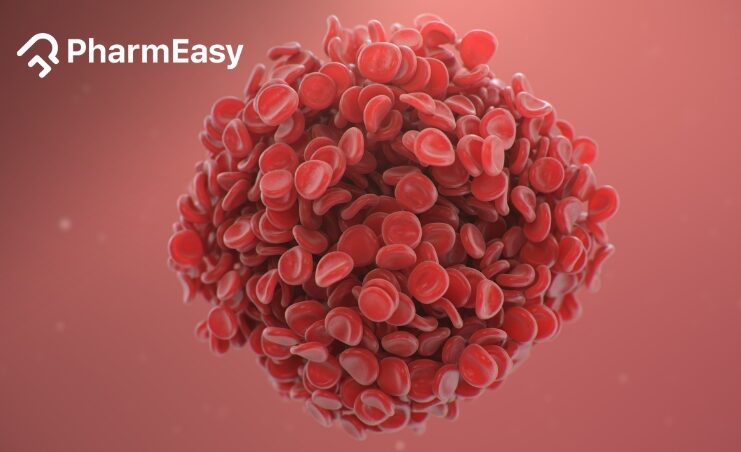Introduction
In this article, we will explore what platelets are and their functions. We will also discuss the reasons behind high platelet counts, what issues it can cause, and how we can test for it. We’ll even provide a guide on how to manage it, all while exploring the importance of staying healthy and proactive.
Did you know?
- High platelet count is more common in individuals with rheumatoid arthritis1.
- High platelet count is associated with an increased risk of thromboembolic events2.
- High platelet counts can lead to confusion, migraines, seizures, and upper body discomfort3.
- People with high platelet counts may have a larger than normal spleen3.
What are Platelets?
Platelets, also called thrombocytes, are small cell fragments produced in the bone marrow, which circulate in the blood stream. They play a big role in stopping blood loss after injury. They help with:
- Blood clotting: When you get a cut, platelets bind together to form a plug. This is called clotting. It helps to stop bleeding.
- Wound repair: Platelets also help wounds repair. They release growth factors that help your body recover quicker.
Platelet count and its significance
- Normal platelet count range: The normal platelet count falls between 150,000 to 350,000 per microliter of blood4.
- Platelet count blood test: Your healthcare provider may suggest a platelet count blood test. This test helps find the number of platelets in your blood. Abnormal platelet levels could point to health issues that need extra tests or treatment.
Causes of High Platelet Count
High platelet count falls into two groups: essential thrombocytosis and secondary thrombocytosis.
1. Essential thrombocytosis
This is also known as primary thrombocytosis. It happens when there’s excess platelet production in the bone marrow. No clear cause for this can be found. It’s not common, but some gene changes are linked to it5.
- Genetic factors: About half of those with essential thrombocytosis have a specific JAK2 gene change. This plays a big part in causing this disorder.
- Clonal Myeloproliferative Disorders: Other clonal disorders (disorders of proliferation and maturation) that may be present with elevated platelet counts include polycythemia vera and primary myelofibrosis.
2. Secondary thrombocytosis
This is also known as reactive thrombocytosis. This means having high plates due to an existing health issue. Some sources of reactive thrombocytosis are6:
- Infections: Acute or chronic infections (eg, tuberculosis) can trigger a reactive rise in platelet count.
- Inflammation: Chronic inflammatory diseases like inflammatory bowel disease can stimulate platelet production.
- Allergic conditions: Conditions linked to allergies, like hay fever or food allergies, can increase platelet counts.
- Anaemia: Low red blood cells and haemoglobin can send platelet numbers up. This happens with iron-deficiency anaemia and haemolytic anaemia.
- Asplenia: The absence of spleen can also cause high platelets. This can be because of surgery or the spleen not working right.
- Medications: Some drugs disrupt the normal balance of blood cells. This can lead to high platelets. Such drugs include certain antibiotics.
- Post-surgery or trauma: Injuries or surgeries can also cause reactive thrombocytosis as the body tries to repair the wounds.
- Cancers: Certain cancers (like lungs, breast etc.) can cause secondary thrombocytosis via cytokine release.
Symptoms of High Platelet Count
Common symptoms
- Fatigue: Tiredness is one. Doing day-to-day tasks could be difficult. It also impacts the overall quality of life.
- Headache: Headache is another sign. It can make you uncomfortable. Sometimes, it might even be very painful.
- Dizziness: Some people also report dizziness. This can disrupt balance and coordination.
Severe conditions
In some cases, high platelet counts can cause more serious health problems. These include the following.
- Blood clots: A high platelet count can increase the risk of blood clots forming. These clots can cause dangerous health problems like a heart attack or a stroke.
- Bleeding problems: While rare, very high platelet counts can cause abnormal bleeding. This includes symptoms like nosebleeds or bloody stools.
Many a times there are no symptoms of high platelet count, and people find out in routine blood checks. However, common symptoms such as headache, fatigue and dizziness may occur. It is best to discuss with a doctor if these symptoms are persistent as they may point towards a larger medical condition.
The majority of thrombocytosis cases are identified around age 60. Essential thrombocythemia is diagnosed in women twice as frequently as in men10.
Dr. Siddharth Gupta, B.A.M.S M.D (Ayu)
Complications Associated with High Platelet Count
Those with a high platelet count face certain risks. These include:
- Blood clots: Blood clots due to high platelet count can cause heart attacks or strokes. These need quick medical help and can be deadly if not treated6.
- Pregnancy complications: If an expecting mother has an uncontrolled high platelet count, risks are increased. These risks include miscarriage, high blood pressure during pregnancy, and premature birth5. This is why regular tests, and the right medical care are vital.
- Progression to blood cancers and disorders: In rare cases, essential thrombocythaemia can turn into blood cancers or disorders. These include leukaemia and other rare blood disorders6. Quick action can lessen these risks.
To my knowledge, thrombocytopenia (increased platelet count) is commonly seen in both mild and serious dengue conditions. One should consult their doctors to analyse the blood test reports precisely11.
Dr. Rajeev Singh, BAMS
Diagnosis of High Platelet Count
Once a high platelet count is found via blood tests, your healthcare provider will suggest further tests. These might include the following:
1. Laboratory tests
- Complete blood count (CBC): A CBC test looks at all blood cells, including white blood cells, red blood cells, and platelets.
- Blood smear: A blood smear lets doctors see cells under a microscope4.
2. Imaging studies
- Ultrasound: An ultrasound can help detect any issues with organs like the liver or spleen. Things to look out for are swelling or inflammation.
- CT scan: In some cases, a CT scan is needed to look at organs in more detail.
- MRI: Also, an MRI could be used to get a clear picture of the organs and vessels7.
3. Bone marrow biopsy
The final step might be a bone marrow biopsy. This means taking a small sample of bone marrow for checking. Doing this can see how cells grow and if there are signs of disease8.
Management Options for High Platelet Count
1. Addressing the underlying cause
- Managing infections: Any infections might need antibiotics or antiviral drugs. Treating them can lower high platelets.
- Managing chronic diseases: Proper control of long-term health problems may have a positive impact on high platelets.
2. Medications
Medications commonly prescribed by doctors include:
- Platelet-Lowering Agents: These are used to reduce platelet production in the bone marrow. Examples include4:
- Antiplatelet therapy: These stop the platelets from clumping together to form clots. Example includes4:
3. Lifestyle changes and self-care
- Exercise: Having a regular workout may keep you healthy and your blood flowing smoothly.
- Nutrition: Eating a varied, healthy diet may help your body fight off illness. It also supports overall wellness.
- Stress management: Paying attention to reduce stress may help lessen platelet count and function. This could be through things like meditation or therapy.
Measures to Reduce the Risk
- Regular check-ups: Getting medical check-ups on a regular schedule helps to track your health. This helps notice issues early and work on them9.
- Maintaining a healthy lifestyle: Keeping a balanced life with good exercise, diet, and stress control may keep off many health issues.
- Early detection and intervention: Working quickly on any health concerns reduces risks. Therefore, don’t wait before talking to your healthcare provider if anything seems off.
Also Read: Normal Platelet Count: Causes, Symptoms & Management of Abnormal Levels
Conclusion
In short, it’s really important to know about and manage high platelet count for overall health. Being proactive in your health, including regular doctor visits, healthy living, and quick action is key. With all the information in this article, you’re now better equipped to deal with platelet issues in case you notice any symptoms.
Also Read: Causes of Low Platelet Count & Tips for Improving Them
Frequently Asked Questions (FAQs)
What does it mean if your platelets are high?A high platelet count, or thrombocytosis, means more than normal platelets are in your blood. This might point to a deeper health concern or it could be just a reaction to infection, inflammation, or a temporary issue.
Is 500 a high platelet count?
Yes, 500 (or 500,000 per microliter) is seen as a high count. This is because normal levels are from 150,000 to 450,000 per microliter of blood.
What is the alarming level of platelets?Any count above 450,000 per microliter is worrisome. The severity of the situation depends on the root cause and any possible health issues. Concerns might include a higher risk of blood clots or bleeding issues.
What cancers cause high platelet count?Several cancer types have been linked to high platelets. These include ovarian, lung, and breast cancer as well as some other types like lymphoma and leukaemia.
When should I be concerned about high platelet count?It’s time to worry if a high platelet count comes with signs like tiredness, headache, dizziness, blood clots, or bleeding. Speaking to your healthcare provider is vital to find out the root cause and what therapy might help.
Can a high platelet count cause blood clots?High platelets can increase the risk of blood clots being formed. This can lead to serious problems like deep vein thrombosis, pulmonary embolism, heart attack, and stroke.
References
- Gasparyan AY, Ayvazyan L, Mukanova U, Yessirkepov M, Kitas GD. The Platelet-to-Lymphocyte Ratio as an Inflammatory Marker in Rheumatic Diseases. Ann Lab Med. 2019 Jul;39(4):345-357. Available from: https://pmc.ncbi.nlm.nih.gov/articles/pmid/30809980/
- Simanek R, Vormittag R, Ay C, Alguel G, Dunkler D, Schwarzinger I, Steger G, Jaeger U, Zielinski C, Pabinger I. High platelet count associated with venous thromboembolism in cancer patients: results from the Vienna Cancer and Thrombosis Study (CATS). J Thromb Haemost. 2010 Jan;8(1):114-20. Available from: https://pubmed.ncbi.nlm.nih.gov/19889150/
- National Heart, Lung, and Blood Institute. Platelet Disorders: Thrombocythemia and Thrombocytosis [Internet]. NHLBI; [cited 2025 Jul 2]. Available from: https://www.nhlbi.nih.gov/health/thrombocythemia-thrombocytosis
- National Williams O, Sergent SR. Histology, Platelets [Internet]. Treasure Island (FL): StatPearls Publishing. 2025 Jan; [updated 2022 Nov 14; cited 2025 Jul 2]. Available from: https://www.ncbi.nlm.nih.gov/books/NBK557800/
- Ashorobi D, Gohari P. Essential Thrombocytosis [Internet]. Treasure Island (FL): StatPearls Publishing. 2025 Jan; [updated 2023 Aug 6; cited 2025 Jul 2]. Available from: https://www.ncbi.nlm.nih.gov/books/NBK539709/
- Rokkam VR, Killeen RB, Kotagiri R. Secondary Thrombocytosis [Internet]. Treasure Island (FL): StatPearls Publishing. 2025 Jan; [updated 2024 Aug 6; cited 2025 Jul 2]. Available from: https://www.ncbi.nlm.nih.gov/books/NBK560810/
- Mehta P, Reddivari AKR. Hepatitis [Internet]. Treasure Island (FL): StatPearls Publishing; 2020 Jan– [cited 2025 Jul 2]. Available from: https://www.researchgate.net/publication/347581660_Hepatitis_-_StatPearls_-_NCBI_Bookshelf
- Jinna S, Khandhar PB. Thrombocytopenia [Internet]. Treasure Island (FL): StatPearls Publishing. 2025 Jan; [updated 2023 Jul 4; cited 2025 Jul 2]. Available from: https://www.ncbi.nlm.nih.gov/books/NBK542208/
- National Heart, Lung, and Blood Institute. Living with platelet disorders [Internet]. NHLBI; [cited 2025 Jul 2]. Available from: https://www.nhlbi.nih.gov/health/platelet-disorders/living-with
- Cleveland Clinic. Thrombocytosis: Symptoms, Causes & Treatment [Internet]. Cleveland (OH): Cleveland Clinic; published online (approximately 8.2 years ago) [cited 2025 Aug 21]. Available from: https://my.clevelandclinic.org/health/diseases/13350-thrombocytosis
- Hottz ED, Oliveira MF, Nunes PC, Nogueira RM, Valls-de-Souza R, Da Poian AT, Weyrich AS, Zimmerman GA, Bozza PT, Bozza FA. Dengue induces platelet activation, mitochondrial dysfunction and cell death through mechanisms that involve DC-SIGN and caspases. J Thromb Haemost. 2013 May;11(5):951–962. doi:10.1111/jth.12178. PMID:23433144; PMCID:PMC3971842.Available from: https://pmc.ncbi.nlm.nih.gov/articles/PMC3971842/
Disclaimer: The information provided here is for educational/awareness purposes only and is not intended to be a substitute for medical treatment by a healthcare professional and should not be relied upon to diagnose or treat any medical condition. The reader should consult a registered medical practitioner to determine the appropriateness of the information and before consuming any medication. PharmEasy does not provide any guarantee or warranty (express or implied) regarding the accuracy, adequacy, completeness, legality, reliability or usefulness of the information; and disclaims any liability arising thereof.
 12
12 
























Comments